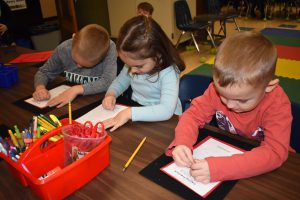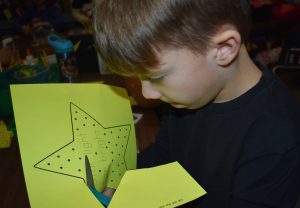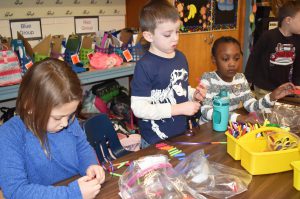
Minisink Valley Elementary kindergarteners are strengthening and further developing their fine motor skills during fun activity sessions which will better prepare them to complete daily fine motor tasks both in school and at home.
A recent visit to Marjori Bobish’s class showed just how much fun the little students were having, while probably not even realizing the true benefit of their work, and what’s going on in all eight kindergarten classrooms on a daily basis.
“Fine motor skills involve the use of precise and coordinated movement of the fingers to perform hand use tasks,” said Mrs. Bobish. “Fine motor skills are necessary for completing daily tasks such as dressing (using buttons and zippers), feeding (using mealtime utensils); being a student (using a keyboard, pencil or scissors) and leisure and play activities (drawing or playing musical instruments.”

In class, Mrs. Bobish’s students work on their fine motor skills during their morning center activity work. During the week, Mrs. Bobish will introduce what the four days’ worth of activities will be on Monday, and student groups will rotate through the four centers during the balance of the week. Each center is directly connected to a theme or content area that is being taught or needs review, she added.
Hole punching and much more
While hole punching, beading, using with Play Doh, threading or making tiny glue dots may seem simple enough, not all children have enough practice doing such things.
But they represent important skill abilities which are then transferred to more important life and school skills.
For example, hole punching is an opportunity to develop the foundation skills required for scissor usage and pencil grasping. It helps with the development of the arches of the hand, skills control of the thumb, index and middle fingers fingers and stabilization of the ring and little fingers, she explained.
Glue dots require students to make small glue dots and place small items on those glue dots, Mrs. Bobish said, which helps for hand strengthening and muscle development.
The additional benefits of students’ work include perfecting eye-hand coordination and the cognitive skills of planning, problem solving visual discrimination.
“Fine motor skills impact critical areas of physical development, and the development of academic foundational skills by improving a child’s ability to write, draw, color and cut,” she said. “The structure and organization of the centers also allow the children an opportunity to foster their independence.”
Activities tied to the letter “S”
During that recent visit, students were focused on the letter “S” and the sound the letter “S” makes, with the fine motor skills activities tied to these “S” words: Star, straws, stocking and Santa.
Students were making tiny glue dots in order to glue tiny stars onto a larger yellow star which they needed to cut out with scissors; stringing colored, cut straws into yarn following a prescribed pattern; using a tracing paper to punch a patterned Santa onto red paper with punch pins; and threading/sewing white yarn onto a red, hole-punched paper stocking and later adorning it with white cotton balls.
“I like the cotton balls and I like tracing and I like to sew because it’s really fun,” Fiona Contino said breathlessly. “I’m going to bring it home and show my mom. I think she will like it, but she doesn’t like cotton balls. But I think my dad will love it.”

Jameson O’Connell was busy finishing up his straw necklace, careful to ensure he was following the pattern requested by his teacher.
“I got a lot done,” he said, looking at his work. “But I’m going to wear it because it won’t fit my mom or dad.”
Lillianna Rubbert also took time to review her work.
“I never sewed, but my aunt sews, “she said. “I like to use my fingers because it will help me to write my name, and I’m very proud of my name.”
At the “star” center, Sofia Tropiano was busy making tiny glue dots.
“We are learning about the letter ‘S,’” she said. “I learned when you stick the star on your finger and put it on the glue, it will make the star stick just perfectly.”
And, busy at the push pin Santa activity was Christopher Rodrigue Jr.
“This is the best I did,” he said gleefully. “You just need to push down a little hard. I think it will take a long time to finish because there’s a lot to push down on. This is going to be a Christmas present for my mom and dad, because I really love my mom and dad.”
